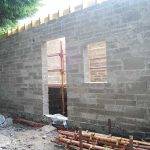Minimum requirements when installing a treatment system
All septic tanks and packaged treatment systems (NI & ROI) must be tested to EN12566 for strength, water tightness and performance and have the approved test certificate. They must also be CE certified. All systems must be professionally designed and be fit for purpose. In ROI, refer to the Environmental Protection Agency’s Code of Practice for further guidance. In all cases know that surface water and rainwater from the roof should not be diverted to your wastewater system – in heavy rainfall this could cause solids to be flushed out of the tank!
In NI you will need to apply to the Department of the Environment for a consent to discharge to a waterway or to underground strata, with form WO2 (£100 or £250 fee depending on whether an application to discharge to an underground stratum or to a waterway is made). A certificate will be issued if you get consent; retain this legal document as it may be required in the future, e.g. for insurance or your mortgage application. It will state the conditions under which you can discharge, and will include an obligation to desludge and maintain your treatment system according to the manufacturer’s instructions. You must keep a record of the maintenance that has been carried out on the system.
In ROI you will need to get consent from your local authority to build a treatment system as part of your planning application. The site assessor’s report, derived from your percolation test, will have to be submitted with the application; in it an outline of what type of treatment system is suitable will be given. In ROI discharging to surface water requires a pollution license, which is very unlikely to be granted by your local authority. In essence, in ROI septic tanks and packaged systems must discharge to the groundwater and must do so via a tertiary treatment system (percolation area/polishing filter).
You will also have to register your treatment system with your local authority; the charge to do so is €50 and it can be done online www.protectourwater.ie, tel. 1890 800 800, in your local authority’s council offices, at a public library or at a citizen’s information centre.
You will have to carry out a visual inspection of your tank every year, including making sure only domestic wastewater is treated in the tank and that it is not discharging in streams and ditches; any repairs deemed necessary will have to be made by you. In the case of a septic tank you must desludge regularly (see table below).
[adrotate banner="58"]Inspections are being carried out by your local authority (free of charge); these are currently focusing on areas deemed to be sensitive, such as those near waterways. If your house is chosen, your local authority will contact you at least 10 days before the inspection is to take place. The results will be shared with you within 21 days of the inspection.
If you’ve been inspected and are in breach of the legislation, then you could get a grant to help you with the repairs but you must have had your system registered before the 1st of February 2013. If your household income is less than €50,000 you can apply for an 80% grant (maximum payable €4,000), if your income is between €50k and €75k you can get 50 per cent (maximum payable €2,500). The grants are for repairs or replacement only, not for desludging, servicing or maintaining the system.
Septic tanks (primary treatment)
Septic tanks can have a bad reputation but they can work perfectly well, as long as the site is suitable and they are properly designed, (including size and location), installed and maintained. On good agricultural grade land a basic septic tank system with a percolation area may be all you need although be advised that nowadays you’ll probably be told to install a secondary treatment system to ensure a better quality of effluent. For a small domestic installation, prices typically start at €4,000/£3,300.
A septic tank is a miniature sewage works involving neither electricity nor pumps. The tank is divided into two wastewater holding chambers containing millions of anaerobic (non-oxygen using) bacteria. These break down raw sewage and separate the liquid, (known as liquor), from the solids. The solids collect at the bottom and are referred to as sludge. The remaining effluent will then pass through to a percolation area (hence the need for a percolation test), for further treatment and polishing.



2 Comments